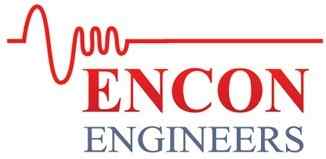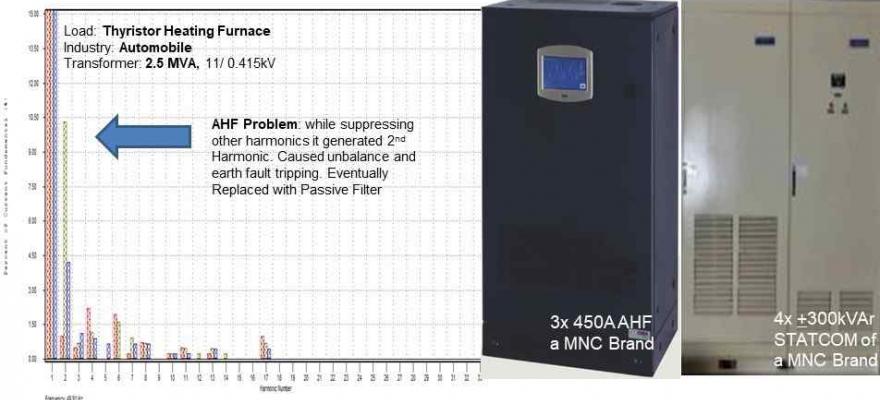
Active Harmonic Filter
Read this case study of the advantages and disadvantages of the active harmonic filter and how passive filter installation removes harmonics, voltage surges and improves PF. Besides, the active harmonic filter needs the support of a stable external power source for injecting phase opposite current harmonics to downstream loads. Its efficacy depends upon the stability of the connected external power source.
AHF design needs passive components like a capacitor and a resistor, but it can either do harmonic control or power factor correction to its 100% rating. In the case of both PF improvement and harmonic reduction, its capacity needs a derating to 50%. The active harmonic filter is a load in an electrical power system that generates anti harmonics at 180degree phase opposite. AHF has energy losses. Most OEM pdf catalogues declare the kWh losses at 3% under laboratory measurement.
Active Harmonic Filter does not eliminate downstream harmonic, electronic failure, equipment and relay tripping.
By design, it doesn't remove harmonics from downstream power line but by injecting anti-harmonic cancels it to prevent it from flowing into the upstream utility supply. Its application is to limit upstream grid harmonics within IEEE-519 norm. Whereas passive harmonic filter being a harmonic absorption type sucks up harmonics by short-circuiting it from the downstream load as well as upstream power system within its range. By doing so, it cleans up the circulating-harmonic from downstream loads which otherwise get absorbed in the downstream equipment and In turn, increase voltage harmonic distortion within the supply transformer. In a chain reaction, that otherwise would magnify the current harmonics extent of which depends upon the fault level of the load bus PCC. Thus, by design passive harmonic filter relieves all downstream loads by removing the circulating-harmonics that eliminate equipment failure, break-down and nuisance tripping on voltage fluctuation. It improves Protection Relay functioning - read it in another case study at Solar Power Inverter with Harmonic Filter.
Active Harmonic Filter has energy losses. Series impedance causes VFD tripping. Why a drive-wise harmonic correction is not a good idea.
It requires real-power in kW for injecting phase-opposite harmonic current coming from the downstream non-linear load. That causes a minimum of 3% real energy losses in kWh term. Though OEM catalogue mention only about 3% energy loss, that's measured under an ideal condition. Energy-intensive industries employ hundreds of VFD drives within one transformer say 2000 KVA and operate in between 70 to 90% load factor. It requires higher impedance typically over 3% in series with VFD drive which injects further kW losses. Thus the 3% energy loss data may be valid for low-intensity load, but for higher load-factor and THDv, the total losses including in the high-value series impedance may go up to beyond 3%.
Some consultants prefer to have a drive-wise harmonic filter which is not a wise thing to do though in particular when the supply transformer has too many VFD drives. Active front end harmonic filters use high impedance upfront with its connected VFD drive. Summarily, it magnifies power system impedance which in turn increases THDv, disturbs VFD operation making it susceptible to tripping for even a minor grid voltage fluctuation.
It has a known problem connecting with backup diesel generator (DG) if plant loads are high and need variable reactive power compensation. The active harmonic filter can't deliver that as it inherits only a fixed and limited design capacitor. An extra Power Factor control panel is required. A STATCOM to work in conjunction with it or the SATCOM to be inbuilt within it. Some AHF manufacturers use an additional external APFC capacitor bank or a detuned harmonic filter which they refer to as a hybrid harmonic filter. A detuned filter does not control harmonics. It uses a detuned reactor in series for the protection of capacitors and not for eliminating the load harmonics.
Active Harmonic Filter - advantages
The active harmonic filter does not require to be custom built since it is mostly impedance independence except the designed capacitors and resistors. It does not need any load specific frequency tuning. Active harmonic filter manufacturers claim it can handle wideband harmonic frequencies. On the other hand, the passive harmonic filter needs extensive engineering efforts and are custom built with load specific design. However, it is also true that the actual-load never generates beyond a few harmonic frequency bands. For example, computer, server and switch mode power supply (SMPS) loads produce 3rd and 9th harmonic currents to the extent of 75% and 15% respectively. Six pulse drive loads produce 5th (60%), 7th (20%) and balance in 11th and 13th harmonic currents. 12-Pulse inverter loads generate 11th (50%), 13th (20%), 5th (20%) and balance in other frequency harmonic currents.
Active Harmonic Filter- disadvantages
Active Harmonic Filter has a known issue in handing high-intensity loads wherein THDv is above 10% and without a linear-load mix for which many OEM recommend not to use it. It also creates energy losses which vary from 3% for low-intensity loads and goes up to 7% for high-intensity loads and voltage distortions. Whereas passive filter being harmonic absorption type saves 3 to 5% real energy in kWh for moderately polluted harmonic loads. When it comes to massively polluted harmonic load like in rolling mill drive with a fourth quadrant regeneration operation, induction furnace etc., it delivers an even higher percentage of energy saving. The same higher percentage energy saving is possible when the transformer or DG operates at a higher load factor typically in between 80 to 90% and with a very high THDv.
Active Harmonic Filter malfunctions when THDv is high and is used without a linear-load mix
It malfunctions while handling high-intensity power and harmonic pollution wherein the total voltage harmonic distortion (THDv) is above 10%. Many OEM recommends not to use it when THDv is more than 10%. While the higher THDv problem is universal, it has another issue when the load doesn’t mix with some linear-load like full speed induction motor and the current harmonic percentage is high. We have independently verified these features in the following two case studies which are detailed below.
Automobile Industry AHF with high THDv - a Case Study
Active Harmonic Filter- problem with high intensity variable load

While the active harmonic filter can regulate variable harmonic currents from the downstream non-linear load, it can't control reactive power on its own unless it works in conjunction with STATCOM. It inherits the fixed design capacitors which restrict it from scaling up for higher loads that including applying it at the transformer or DG PCC for the full utility load which may include hundreds of VFD drives and other non-linear loads. Instead, active harmonic filter manufacturers install it in numbers across several and smaller non-linear loads within the same transformer. Back up diesel generator (DG) requires a closer power factor (PF) management. It's a known issue for applying it at the generator terminal.
Passive filter though needs custom engineering effort is custom built for any variable load. It's applied conveniently at transformer's main income or DG terminal for the entire supply load which may comprise hundreds of variable speed drive (VSD), DC drive, converter, inverter, computer server and other non-linear loads. It is custom built to regulate any variable reactive power demand from the downstream load. Be it the most challenging fourth quadrant regeneration drive which operates at a power factor of about 0.06 lag, and generates in between 80% to 120% current harmonic with a corresponding voltage harmonic generation. We have applied passive filters across thousand of diesel generators (DG) and also at Turbo generators (TG) since our inception in 1995. With the elimination of both voltage and current harmonics, it debottlenecks DG/TG's capacity limitation which allows extra load on the DG to the extent of 30%, solves its hunting, AVR voltage fluctuation problem and saves good energy and fuel.
Active Harmonic Filter- failure issue with power surge and voltage fluctuation

Unlike the passive filter, an active harmonic filter is not an energy storage device. One of the advantages of the passive filter it's an energy storage device which acts as an electrical flywheel and eliminates equipment tripping due to momentary voltage fluctuation which originates either from factory's internal power system or external from the utility's grid supply. The consequences of poor power quality vis-a-vis voltage sag tripping are high. Industries worldwide lose billions of dollars every year on account of equipment nuisance tripping due to voltage fluctuation.
Whereas active harmonic filter being dependent on an external power source is susceptible to failure on voltage fluctuations. Several active filter manufacturers void their warranty if failure happens on account of a voltage fluctuation which can be a subjective clause. Besides, it needs air-conditioned room for its installation. Passive filter, on the other hand, is rough and tough and is installed within the ordinary electrical panel room. Several of our clients are in the path of monsoon wind and have had a history of equipment tripping with its sensitive process drives and server networks. Since our inception in 1995, we have been supplying hundreds of passive filters for eliminating nuisance tripping with VFD drive, DC drive, computer, server network and electrical equipment due to grid power surge and voltage fluctuation.
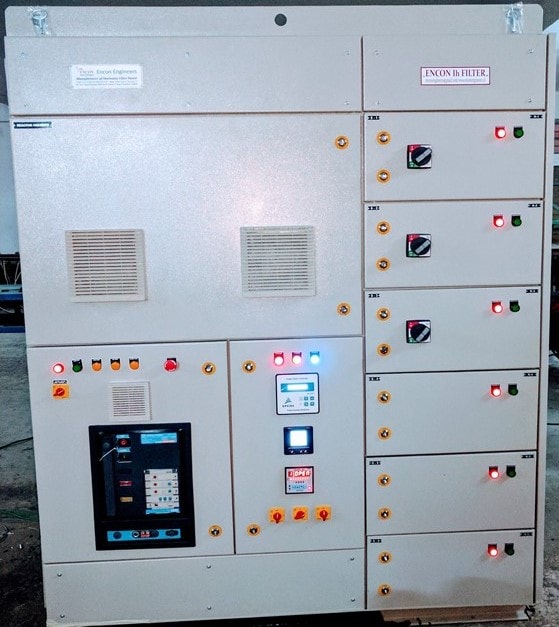
Active Harmonic Filter- stability issue
The passive filter provides guaranteed stability and its sustainable through the test of time. It can be scaled up practically for any voltage, current and reactive power compensation need. We have supplied it for all industrial voltage rating up to 36kV and current rating up to 5,000 amps in a single filter. Whereas, the active harmonic filter is susceptible to maloperation if installed in a harmonic-rich power system. While cancelling harmonics across large frequency ranges, it ends up in generating another range harmonic frequency. As shown in the top harmonic bar-chart, it faulted and generated a 2nd harmonics. It's failure rates are high. The disposal for failed electronic components is always environmentally challenging. Whereas, passive filter even though requires a custom design, is for a lifetime.
Active Harmonic Filter and arc flash and short circuit compatibility
Active filters don't comply with arc flash and short circuit compatibility norms. It has high failure rates and has a shorter lifespan. Its operation and maintenance are a challenge that needs highly experienced personnel. Whereas, passive filters comply with arc flash and short circuit norms and can handle the entire transformer or DG loads. Its designed for full load variation with automatic operation including changeover from utility power to back up DG and vice versa. It's fit and forget type and does not require any special maintenance except regular maintenance as like with any electrical equipment.
Active Harmonic Filter- Automobile Industry
In this case study, a set of active harmonic filters applied in conjunction with STATCOM at the main PCC of a transformer with back up DG for the entire transformer load in the automobile industry. Followings are brief project specification.
Industry: Automobile
Transformer size: 2500 KVA, 11kV/ 433V
Transformer Load: Thyristor Heating Furnace, 2nos 600kW and 1no 1200kW
Transformer Load Factor: Average 70%.
Back up DG: Fully backed up by DG in case of power failure
Active Harmonic Filter Specification: 3nos each 450A
AHF Brand: from a leading MNC company.
STATCOM: 4nos +/- 300 kVAr
Brand: from a leading MNC company.
Active Harmonic Filter vs Passive- harmonics before and after filters
Plant Harmonic level without any Harmonic Filter: Shown in Fig.1
Plant Harmonic level with a 700A Passive Filter: Shown in Fig.2
700A Frame Passive Harmonic Filter: Shown in Fig.3
Plant Harmonic with Active Harmonic Filter: Shown in the top caption picture.
The problem with active harmonic filter is that while mitigating wideband harmonic frequencies, it randomly generated some other frequency harmonic causing unbalance in the power supply of the furnace. Its manufacturer could not resolve the problem which created voltage unbalance and occasional earth fault trip resulting in productivity losses.
The active filter itself failed repeatedly. Eventually, we installed a passive filter. It resolved the unbalance and tripping problems. The mitigated harmonic spectrum with passive filter shown in Fig.2 which is self-explanatory. It mitigated the plant's overall harmonic level at the supplying transformer PCC better than IEEE 519 standard.
FMCG Packaging Industry AHF without a linear load mix - a Case Study
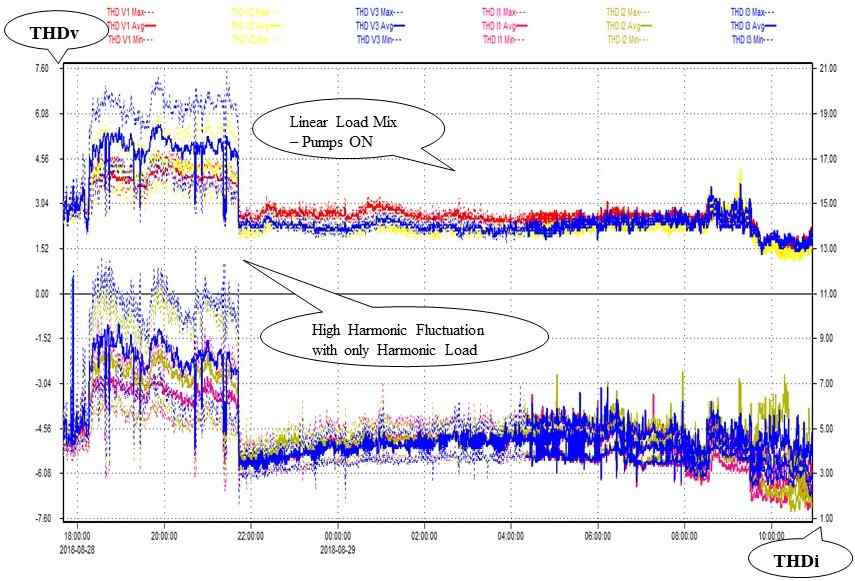
In this case study, a packaging plant was facing a high incidence of VFD drive and electronic component failure even after the installation of an 200A active harmonic filter at the 1250kva transformer's 415v incomer PCC following a recommendation from its OEM after conducting a harmonic study.
The supply transformer also had a 1250kva automatic servo-voltage controller.
Undertaking the root-cause analysis, we recorded power and harmonic profile graphs at the transformer's 415v incomer wherein also connected are the AHF and the Voltage-stabilizer.
The measurement graphs for "THDv vs THDi" and "Voltage vs Current" are in Fig.4 and Fig.5 respectively. Beginning a few hours when only the packaging machines which have a high degree of VFD drives were operating, the active harmonic filter malfunctioned that caused high fluctuation in THDv, THDi and transformer's supply voltage profile.
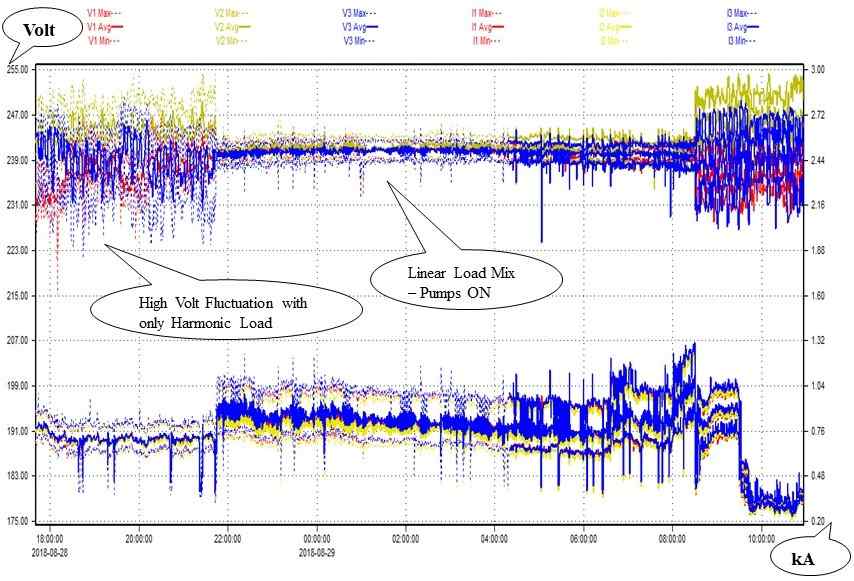
Further, it created resonance at 350 and 550hz impedance lines magnifying 7th and 11th harmonic currents and harmonic voltages.
After a few hours, constant-speed induction motors were switched-ON. With the mix of linear-loads along with the non-linear packaging machine loads, the active harmonic filter started functioning OK.
